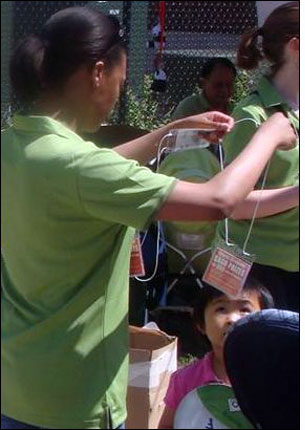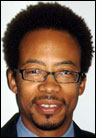The Dragon Boat Race for Literacy is an annual event that typically draws 10,000 participants and spectators to Ping Tom Park, in Chicago’s Chinatown. The festival features not only a race between ornate, oar-powered wooden boats, but also musical, dance and acrobatic performances, as well as food. Since 1999, the Chicago Chinatown Chamber of Commerce has hosted the festival, which raises money to support literacy and promote culture and diversity in neighborhood schools.
But this year’s Chinese Dragon Boat Race, held on July 25, marked the first time the organizers employed radio frequency identification to track the movement of people throughout the 12-acre city park, in order to measure where individuals of various demographics spent their time.
The RFID system was provided by Lygase RFID Solutions, a Wheeling, Ill., RFID technology company. Lygase’s marketing director, Joyce Jeng—as the owner of a business called Asian Social Network—was acquainted with members of the Chicago Chinatown Chamber of Commerce, and was also a race participant. Jeng brought the chamber and Lygase together for the 2009 spring event. With approval from the Chicago Chinatown Chamber of Commerce, Lygase installed RFID readers at several key locations in the park, as well as at a table at the entryway to distribute RFID tags. Because it was a pilot, Lygase did not charge the chamber for the service, though it did provide the results when the event was completed, according to Ketrus Collins, the company’s president and CEO.
For its part, Lygase wanted to test whether it could accurately track the movement of individuals in a crowded venue, so as to gain information about that movement for use by those who participated in organizing the event. By gaining a better understanding of where people go, as well as which attendees tend to go to which locations, the event’s organizers could better plan the location of programs throughout the park to improve traffic flow. What’s more, individual vendors—such as those selling food or beverages—could benefit from knowing where customers would be. The system could also enable organizers to see how many people were in a particular location, and thus determine when they may have had an overcrowding problem—especially in hazardous locations, such as on the bank of the Chicago River, where someone could inadvertently be pushed or fall into the water.
On the day of the races, members of Lygase’s staff were at the gate as people entered, offering attendees an EPC Gen 2 UHF passive RFID tag (provided by WS Packaging Group) attached to a lanyard, which they could wear around their necks. Those who took tags (a total of 1,500 people did so) and signed their names were also included in a prize drawing, with $50 awarded every half hour. There were five different types of tags—blue for men, red for women, green for senior citizens and yellow for kids, as well as a fifth tag for the actual boat racers.
In the Lygase software, the unique ID numbers encoded on each tag corresponded with one of those five categories. Employees passed out the appropriate tags to each recipient. Within the park, Lygase installed four RFID readers on existing light posts or on tripods, wired to generators in order to provide power. A reader was installed at the playground entrance, at an intersection at the opposite side of the park, on a canopy adjacent to the bandstand and at the river’s edge. In this way, Collins says, race organizers created zones within the park, though the majority of the park was not within read range of the interrogators.
“Anyone who crossed into any of those zones was recorded,” Collins states. Lygase installed readers from both Impinj and ThingMagic, to test whether the Lygase software was agnostic and could interpret data from either device. In addition, the company tested the read range and read rate of both interrogators. In both cases, he notes, the team was able to read at a distance of more than 30 feet. Each reader was cabled to a laptop computer that received the ID numbers from all RFID tag that passed within range, as well as the time at which each read occurred. The software identified which of the five categories each RFID tag belonged to, based on those numbers. Data was then stored in the laptops until the end of the day, at which time it was retrieved and the company began analyzing the findings.The information Lygase gained included the number of people visiting each area, the average time spent at each location, the number of visits by time of day, and a breakdown of visits by five demographics (boat racers, seniors, adult men, adult women and children).
The boat race data provides the Chinatown Chamber of Commerce with the opportunity to ascertain where the greatest traffic was, and to improve future layouts based on that information. The system determined that the playground was the busiest area for children, women and senior citizens, and that it was most crowded around lunch hour. Those at the river’s edge were more often male than female.
Since the pilot, Lygase has made the system commercially available, for tracking individuals as well as the movement of assets at similar venues, including expositions, with RFID readers installed throughout a location and tags attached to valuable assets. For indoor settings, Collins says, Lygase will install Mojix‘s STAR readers with eNodes that attach to ceilings and can provide real-time location monitoring throughout an entire exhibit hall or conference area. Each eNode excites all passive RFID tags within its read range (typically, 30 feet), and all are cabled together to form the complete STAR system. In this way, people could also be tracked in real time. In one scenario, an individual could provide a name and an e-mail address or phone number during registration, and be given a tag linked to that personal data. Thus, booth operators could access that information using Lygase’s server, in order to know who had visited their booth. If that individual had not been able to speak with a representative, the company could then e-mail a message to that individual at a later date, offering to provide information.
Event planners could also utilize the system to determine where attendees were going, what might be creating bottlenecks, or which booths or kiosk might be inappropriately placed.
At Journal LIVE! 2010, to be held next April in Orlando, Fla., Lygase will deploy its SmartEvents system, including eNodes, to provide 100 percent coverage on the conference floor. The system will offer benefits for attendees, exhibitors, event organizers and event facilities, says RFID Journal‘s founding editor, Mark Roberti. For example, attendees will be able to access reports regarding which booths they’ve visited, and then, upon request, download material about the vendors at those particular booths. What’s more, organizers can receive reports on traffic throughout the exhibit hall, and booth operators can gain details about the number of attendees who visited their booth, compared with other booths.
“Our goal, in using the system, is to provide more and better information to our exhibitors,” Roberti explains. “We hope they will be able to use the data to see whether they are being effective in attracting the right people to their booth, and maximizing the return on investment in the event.” Access to the data will be provided to vendors for a fee.



